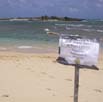 |
| HOME > Field Accounts |
ISLET FIELD ACCOUNTS
Follow the interns and volunteers through their work on the offshore islets. Click on the photos to link to a photo gallery for each visit.
|
|
> 19 Feb 2007: Moku'au'ia (Goat Island), O'ahu
> 29 Feb 2007: Mokulua, O'ahu
> 28 Mar 2007: Kaohikaipu (Black Rock), O'ahu
> 2-3 April 2007: Po'opo'o, Lana'i
> 2-3 April 2007: Pu'u pehe (Sweetheart Rock), Lana'i
> 5 Apr and 7 Apr 2007: Moku'au'ia (Goat Island), O'ahu
> 5-7 Apr 2007: Mokoli'i (Chinaman's Hat), O'ahu
> 29 Apr 2007: Kapapa (Mokukapapa), O'ahu
> 3-4 May 2007: Lehua, Kaua'i and Ni'ihau
> 9 May 2007: Moku'au'ia (Goat Island), O'ahu
> 12 May 2007: Mokoli'i (Chinaman's Hat), O'ahu
> 29-31 May 2007: Molokini, Maui
> 29-31 May 2007: Kaemi, Maui
> 29-31 May 2007: Hulu, Maui
> 1 Jun 2007: Moku'au'ia (Goat Island), O'ahu
> 8 Jun 2007: Moku'au'ia (Goat Island), O'ahu
> 15 Jun 2007: Moku'au'ia (Goat Island), O'ahu
> 22 Jun 2007: Moku'au'ia (Goat Island), O'ahu
> 29 Jun 2007: Moku'au'ia (Goat Island), O'ahu
> 6 Jul 2007: Moku'au'ia (Goat Island), O'ahu
> 18 Jul 2007: Moku'au'ia (Goat Island), O'ahu
> 24 Jul 2007: Moku'au'ia (Goat Island), O'ahu
> 31 Jul 2007: Moku'au'ia (Goat Island), O'ahu
> 7 Aug and 30 Aug 2007: Kapapa (Mokukapapa), O'ahu
> 7 Aug and 30 Aug 2007: Kaohikaipu (Black Rock), O'ahu
> 8 Aug 2007: Moku'au'ia (Goat Island), O'ahu
> 17 Aug 2007: Moku'au'ia (Goat Island), O'ahu
> 17 Aug 2007: Mokoli'i (Chinaman's Hat), O'ahu
> 24 Aug 2007: Moku'au'ia (Goat Island), O'ahu
> 8 Sep 2007: Mokauea, O'ahu
> 10 Sep 2007: Moku'ae'ae, Kaua'i and Ni'ihau
> 18-20 Sep 2007: Mokapu, Moloka'i
> 18-20 Sep 2007: 'Okala, Moloka'i
> 21 Sep 2007: Mokoli'i (Chinaman's Hat), O'ahu
> 22 Sep 2007: Moku'au'ia (Goat Island), O'ahu
> 24 Sep 2007: Kaohikaipu (Black Rock), O'ahu
> 24 Sep 2007: Manana (Rabbit Island), O'ahu
> 14-16 Oct 2007: Mokoli'i (Chinaman's Hat), O'ahu
> 17 Oct 2007: Popo'ia (Flat Island), O'ahu
> 20-21 Oct 2007: Kapapa (Mokukapapa), O'ahu
> 25 Oct 2007: Moke'ehia, Maui
> 26 Oct 2007: Mokupipi, Maui
> 27 Oct 2007: Pu'uku (Pu'uki'i), Maui
> 1 Nov 2007: Po'opo'o, Lana'i
> 1 Nov 2007: Moku mana, Maui
> 2 Nov 2007: Pu'u pehe (Sweetheart Rock), Lana'i
> 2 Nov 2007: Ki'ei, Lana'i
> 10 Nov 2007: Mokauea, O'ahu
> 1-2 Dec 2007: Kaohikaipu (Black Rock), O'ahu
> 9 Feb and Feb 11 2008: Manana (Rabbit Island), O'ahu
> 15 Feb 2008: Mokuho'oniki, Moloka'i
> 16 Feb 2008: Moku manu, Moloka'i
> 16 Feb 2008: Kanaha, Moloka'i
> 19 Mar 2008: 'Alau, Maui
> 20 Mar 2008: Mokuhuki, Maui
> 26 Mar 2008: 'Ale'ale, Kaho'olawe
> 26 Mar 2008: Pu'u koa'e, Kaho'olawe
|
|
Moku'au'ia (Goat Island) 8 Aug 2007
|
|
Trip Goal: To assist DOFAW biologists in an attempt to eradicate Yellow Crazy Ants from the islet using Mokoli'i Islet as a control (no bait used). Using the results of our bait preference trials, a new bait was made specifically for controlling Yellow Crazy Ants in Hawai'i. This ant species has disrupted seabird colonies and ecosystems elsewhere in Hawai'i and around the tropics, but eradication has been troublesome. A successful eradication on Moku'auia would be great step in restoring these fragile island ecosystems to their natural state. Accomplishments: Over the course of 3 months, we completed 2 ant bait applications and conducted intensive monitoring of the ant and seabird populations. We were able to significantly reduce ant numbers, but not eradicate them entirely. However, as a result of our experiment, seabirds were able to survive and successfully hatch chicks on the island. No seabird chicks survived on our control islet (Mokoli'i), where ant bait was not applied. More importantly, we have learned from the project and will readjust the bait amounts and timing and will hopefully eradicate the ants soon.
|

Photo Gallery
|
Intern Account: Malia:
"This trip showed the most progress in the decrease of ant population. The ant cards showed the smallest amount of ants we've ever seen on the island. The transect was bare except for some ants being found on the sea grape trees and a small number found in the naupaka bushes. We were unable to find a single ant in the area where a nest of thousands used to reside, and in the nest of a couple hundred, we were only able to find ten ants. Unfortunately, the baby seabird that was found in the last monitoring was killed by the ants. We found at least five other chicks dead on the islet and many more that died as they were hatching. On the other hand, at least ten healthy chicks were found in burrows."
|
|
|